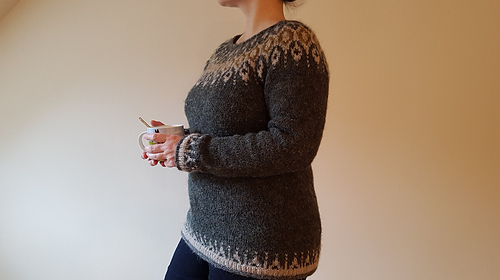It was a long journey, but in the end I solved all problems and learned new skills. For example: three-color knitting with continental and english style. The sweater has now become as desired.
My gauge for Fair Isle was completely different than for stocking stitches. Unfortunately that could not be compensated by different needle sizes (at the end I had a difference of 2 mm). Nevertheless I had additionally to work with decreases. To figure this out, I made huge, involuntary gauges. If you count all the stitches together that I knitted, then I would have knit the sweater two times at least.
I also had to knit the yoke twice because it became too big and long the first time. With increasing length, the finished body and sleeves slid down. As a consolation, I’ve given myself a new color for the second time yoke-knitting: Golden Heather. Previously I had used Mustard and this tone was too low in contrast to the beige basic tone.
In addition, I shortened the pattern significantly and started to decrease much earlier, so that the yoke does not become too long again. That worked. Yeah!
If you work with the metric system in the pattern, it is advisable to calculate the centimeter values yourself, because probably due to the conversion inch / cm the values lead a life of their own.
For example: hem Size D: 200 sts results in 100 cm for the suggested gauge (20 sts per 10 cm). The schematic shows 101.6 cm. Not unimportant when choosing your own size.
Used needle sizes:
Rolling edge: NS 2.5 mm
1x1 ribbing: NS 2.5 mm
Fair Isle: NS 5 mm (19 stitches per 10 cm)
Stockingsts: NS 3 mm (16.6 stitches per 10 cm)
Es war ein langer Weg, aber am Ende alle Probleme gelöst und neue Skills erlernt wie dreifarbiges Stricken mit der Fadenführung über die linke und rechte Hand (continental und english style). Der Pullover ist nun so geworden wie gewünscht.
Meine Maschengröße für Fair Isle war komplett anders als bei glatt rechts. Und das ließ sich auch durch unterschiedliche Nadelstärken (am Ende ergab sich eine Differenz von 2 mm) leider nicht ausgleichen. Somit musste ich beim Wechsel zusätzlich mit Abnahmen arbeiten. Um dies herauszufinden machte ich riesige, unfreiwillige Maschenproben. Wenn man alle Maschen zusammenzählen würde, die ich gestrickt habe, dann hätte ich den kompletten Pullover mindestens 2x gestrickt. Wer nicht rechnen will, muss wohl rippeln!
Den Yoke musste ich auch zweimal stricken, da er beim ersten Mal zu groß und lang wurde. Mit wachsender Länge, rutschten der fertige Body und die Ärmel nach unten. Zum Trost, habe ich mir für das zweite Mal Yoke-Stricken eine neue Farbe gekauft: Golden Heather. Vorher hatte ich Mustard verwendet und dieser Ton war zum beigen Grundton zu kontrastarm.
Zudem habe ich das Muster deutlich verkürzt und viel früher die Abnahmen begonnen, damit der Yoke nicht wieder zu lang wird. Das hat funktioniert. Yeah!
Wenn man mit dem metrischen System in der Anleitung arbeitet, empfiehlt es sich die Zentimeterwerte selber auszurechnen, da wohl aufgrund der Umrechnung inch/cm die Werte ein Eigenleben führen.
Beispiel Hem Größe D: 200 Maschen ergeben 100 cm bei der gewünschten Maschenprobe (20M auf 10 cm). In der Schematic sind 101.6 cm angegeben. Nicht unerheblich bei der Auswahl der eigenen Größe.
Verwendete Nadelstärken:
Rollrand: NS 2,5 mm
1x1 Ribbing: NS 2,5 mm
Fair Isle: NS 5 mm (19 Maschen pro 10 cm)
Stockingsts: NS 3 mm (16,6 Maschen pro 10 cm)
Left over yarn:
1415 Rough Sea: 114 gr
0052 Black: 42 gr
9426 Golden heather: 40 gr
0086 Beige: 24 gr
9264 Mustard: 50 gr
0058 Gray: 22 gr
Total weight: 480 gr

















61771 projects
stashed
58679 times


 handspun
handspun queue
queue favorites
favorites friends
friends needles & hooks
needles & hooks library
library